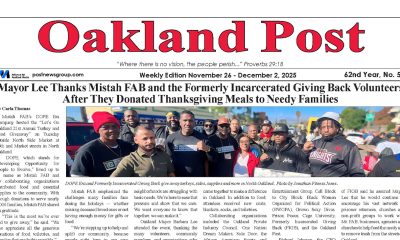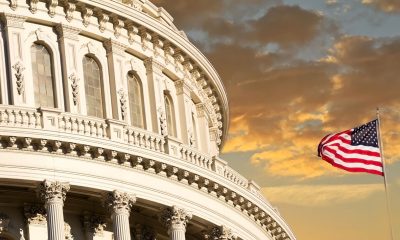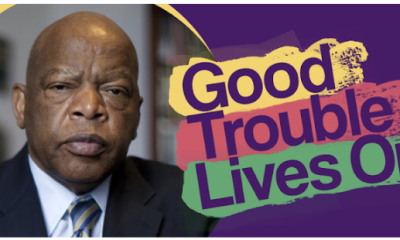Politics
CBO: Deficit to Shrink to Lowest Level of Obama Presidency

In this March 4, 2014 file photo, copies of President Barack Obama’s proposed fiscal 2015 budget are set out for distribution on Capitol Hill in Washington. The Congressional Budget Office says the federal budget deficit will shrink this year to its lowest level since President Barack Obama took office. CBO says the deficit will be $468 billion for the budget year that ends in September. Thats slightly less than last years $483 billion deficit. As a share of the economy, CBO says this years deficit will be slightly below the historical average of the past 50 years. (AP Photo/J. Scott Applewhite, File)
STEPHEN OHLEMACHER, Associated Press
WASHINGTON (AP) — Solid economic growth will help the federal budget deficit shrink this year to its lowest level since President Barack Obama took office, according to congressional estimates released Monday.
The Congressional Budget Office also projects a 14 percent drop in the number of U.S. residents without health insurance, largely because of Obama’s health law.
In a report released Monday, CBO says the deficit will be $468 billion for the budget year that ends in September. That’s slightly less than last year’s $483 billion deficit.
The official scorekeeper of Congress projects solid economic growth for the next few years, with unemployment dropping slightly.
“In CBO’s estimation, increases in consumer spending, business investment and residential investment will drive the economic expansion this year and over the next few years,” the report said.
CBO also cited wage increases, rising wealth and the recent decline in oil prices.
For future years however, CBO issued a warning: Beyond 2018, deficits will start rising again as more baby boomers retire and enroll in Social Security and Medicare. By 2025, annual budget deficits could once again top $1 trillion, unless Congress acts.
At that point, Social Security benefits would account for one-quarter of all federal spending, said CBO Director Douglas Elmendorf.
“The underlying point is that we have a handful of very large federal programs that provide benefits to older Americans,” Elmendorf said. “And with the rising number of older Americans and a rising cost of health care, those programs get much more expensive.”
CBO says the number of U.S. residents without health insurance will drop from 42 million last year to 36 million this year, largely because of Obama’s health law. These numbers don’t include people who are in the U.S. illegally, who are ineligible for subsidies under the health law.
The report says 19 million people will have health insurance because of the law, which could make it harder for congressional Republicans to make good on promises to repeal it.
Obama inherited an economy in recession when he took office. The annual deficit topped $1 trillion for each of his first four years in office, including a record $1.4 trillion in 2009.
As a share of the economy, CBO says this year’s deficit will be slightly below the historical average of the past 50 years.
The federal budget deficit became a big issue during Obama’s early years in office. In 2011, Obama and congressional Republicans struck a deal that resulted in significant spending cuts at many government agencies. At the start of 2013, Obama persuaded Congress to further address the deficit by raising taxes on top earners.
The White House said Monday that Congress still has more to do. “CBO’s longer-term budget and economic projections confirm the need for Congress to act to strengthen our economy for the middle class while putting our debt and deficits on a sustainable trajectory, including by making the investments that will accelerate economic growth and generate good new jobs for our workers to fill,” Deputy Press Secretary Eric Schultz said in a statement.
Declining budget deficits, however, could reduce pressure on Congress to continue addressing the government’s finances.
“Over the last few years as deficits have fallen, so too has the effectiveness of Republican rhetoric about a ‘big government’ boogeyman,” said Sen. Charles E. Schumer, D-N.Y. “Now is the time for Republicans to join with Democrats to invest in constructive programs that help middle-class Americans climb the ladder and achieve the American dream.”
Republicans, however, signaled that they aren’t done cutting spending.
“Thanks to Republicans’ efforts to cut spending this year’s deficit is projected to be smaller, but in order to balance the budget we must address the true drivers of our debt,” said Cory Fritz, a spokesman for House Speaker John Boehner, R-Ohio. “Real, robust economic growth won’t occur until we solve our government’s spending problem.”
CBO projects that the economy will grow at an annual rate of 3 percent in both 2015 and 2016. In later years, however, CBO projects slower economic growth as more baby boomers retire and the labor force grows more slowly than it did in the 1980s and 1990s.
CBO projects the unemployment rate will gradually decrease to 5.3 percent in 2017. It is now 5.6 percent.
“CBO’s report is important, but it only tells us part of the story,” said Sen. Bernie Sanders, a Vermont independent and the ranking minority member of the Senate Budget Committee. “What we must never forget is that tens of millions of Americans today are struggling to keep their heads above water economically while the disparity between the rich and everyone else is growing wider every day.”
The budget agency bases its budget projections on current law, assuming that temporary provisions will be allowed to expire. However, many temporary laws are routinely extended, including dozens of temporary tax breaks and a provision that prevents steep cuts in Medicare payments to doctors.
Future budget deficits would be higher if those provisions are continued. For example, if dozens of temporary tax breaks are extended, they would add $1 trillion to the deficit over the next decade.
___
Follow Stephen Ohlemacher on Twitter: http://twitter.com/stephenatap
Copyright 2015 The Associated Press. All rights reserved. This material may not be published, broadcast, rewritten or redistributed.
Activism
Oakland Post: Week of December 24 – 30, 2025
The printed Weekly Edition of the Oakland Post: Week of – December 24 – 30, 2025

To enlarge your view of this issue, use the slider, magnifying glass icon or full page icon in the lower right corner of the browser window.
Alameda County
Oakland Council Expands Citywide Security Cameras Despite Major Opposition
In a 7-1 vote in favor of the contract, with only District 3 Councilmember Carroll Fife voting no, the Council agreed to maintain its existing network of 291 cameras and add 40 new “pan-tilt-zoom cameras.”

By Post Staff
The Oakland City Council this week approved a $2.25 million contract with Flock Safety for a mass surveillance network of hundreds of security cameras to track vehicles in the city.
In a 7-1 vote in favor of the contract, with only District 3 Councilmember Carroll Fife voting no, the Council agreed to maintain its existing network of 291 cameras and add 40 new “pan-tilt-zoom cameras.”
In recent weeks hundreds of local residents have spoken against the camera system, raising concerns that data will be shared with immigration authorities and other federal agencies at a time when mass surveillance is growing across the country with little regard for individual rights.
The Flock network, supported by the Oakland Police Department, has the backing of residents and councilmembers who see it as an important tool to protect public safety.
“This system makes the Department more efficient as it allows for information related to disruptive/violent criminal activities to be captured … and allows for precise and focused enforcement,” OPD wrote in its proposal to City Council.
According to OPD, police made 232 arrests using data from Flock cameras between July 2024 and November of this year.
Based on the data, police say they recovered 68 guns, and utilizing the countywide system, they have found 1,100 stolen vehicles.
However, Flock’s cameras cast a wide net. The company’s cameras in Oakland last month captured license plate numbers and other information from about 1.4 million vehicles.
Speaking at Tuesday’s Council meeting, Fife was critical of her colleagues for signing a contract with a company that has been in the national spotlight for sharing data with federal agencies.
Flock’s cameras – which are automated license plate readers – have been used in tracking people who have had abortions, monitoring protesters, and aiding in deportation roundups.
“I don’t know how we get up and have several press conferences talking about how we are supportive of a sanctuary city status but then use a vendor that has been shown to have a direct relationship with (the U.S.) Border Control,” she said. “It doesn’t make sense to me.”
Several councilmembers who voted in favor of the contract said they supported the deal as long as some safeguards were written into the Council’s resolution.
“We’re not aiming for perfection,” said District 1 Councilmember Zac Unger. “This is not Orwellian facial recognition technology — that’s prohibited in Oakland. The road forward here is to add as many amendments as we can.”
Amendments passed by the Council prohibit OPD from sharing camera data with any other agencies for the purpose of “criminalizing reproductive or gender affirming healthcare” or for federal immigration enforcement. California state law also prohibits the sharing of license plate reader data with the federal government, and because Oakland’s sanctuary city status, OPD is not allowed to cooperate with immigration authorities.
A former member of Oakland’s Privacy Advisory Commission has sued OPD, alleging that it has violated its own rules around data sharing.
So far, OPD has shared Flock data with 50 other law enforcement agencies.
Activism
Families Across the U.S. Are Facing an ‘Affordability Crisis,’ Says United Way Bay Area
United Way’s Real Cost Measure data reveals that 27% of Bay Area households – more than 1 in 4 families – cannot afford essentials such as food, housing, childcare, transportation, and healthcare. A family of four needs $136,872 annually to cover these basic necessities, while two adults working full time at minimum wage earn only $69,326.

By Post Staff
A national poll released this week by Marist shows that 61% of Americans say the economy is not working well for them, while 70% report that their local area is not affordable. This marks the highest share of respondents expressing concern since the question was first asked in 2011.
According to United Way Bay Area (UWBA), the data underscores a growing reality in the region: more than 600,000 Bay Area households are working hard yet still cannot afford their basic needs.
Nationally, the Marist Poll found that rising prices are the top economic concern for 45% of Americans, followed by housing costs at 18%. In the Bay Area, however, that equation is reversed. Housing costs are the dominant driver of the affordability crisis.
United Way’s Real Cost Measure data reveals that 27% of Bay Area households – more than 1 in 4 families – cannot afford essentials such as food, housing, childcare, transportation, and healthcare. A family of four needs $136,872 annually to cover these basic necessities, while two adults working full time at minimum wage earn only $69,326.
“The national numbers confirm what we’re seeing every day through our 211 helpline and in communities across the region,” said Keisha Browder, CEO of United Way Bay Area. “People are working hard, but their paychecks simply aren’t keeping pace with the cost of living. This isn’t about individual failure; it’s about policy choices that leave too many of our neighbors one missed paycheck away from crisis.”
The Bay Area’s affordability crisis is particularly defined by extreme housing costs:
- Housing remains the No. 1 reason residents call UWBA’s 211 helpline, accounting for 49% of calls this year.
- Nearly 4 in 10 Bay Area households (35%) spend at least 30% of their income on housing, a level widely considered financially dangerous.
- Forty percent of households with children under age 6 fall below the Real Cost Measure.
- The impact is disproportionate: 49% of Latino households and 41% of Black households struggle to meet basic needs, compared to 15% of white households.
At the national level, the issue of affordability has also become a political flashpoint. In late 2025, President Donald Trump has increasingly referred to “affordability” as a “Democrat hoax” or “con job.” While he previously described himself as the “affordability president,” his recent messaging frames the term as a political tactic used by Democrats to assign blame for high prices.
The president has defended his administration by pointing to predecessors and asserting that prices are declining. However, many Americans remain unconvinced. The Marist Poll shows that 57% of respondents disapprove of Trump’s handling of the economy, while just 36% approve – his lowest approval rating on the issue across both terms in office.
-

 #NNPA BlackPress3 weeks ago
#NNPA BlackPress3 weeks agoLIHEAP Funds Released After Weeks of Delay as States and the District Rush to Protect Households from the Cold
-

 Alameda County3 weeks ago
Alameda County3 weeks agoSeth Curry Makes Impressive Debut with the Golden State Warriors
-

 Activism4 weeks ago
Activism4 weeks agoOakland Post: Week of November 26 – December 2, 2025
-

 #NNPA BlackPress3 weeks ago
#NNPA BlackPress3 weeks agoSeven Steps to Help Your Child Build Meaningful Connections
-

 #NNPA BlackPress3 weeks ago
#NNPA BlackPress3 weeks agoSeven Steps to Help Your Child Build Meaningful Connections
-

 #NNPA BlackPress4 weeks ago
#NNPA BlackPress4 weeks agoTrinidad and Tobago – Prime Minister Confirms U.S. Marines Working on Tobago Radar System
-

 #NNPA BlackPress4 weeks ago
#NNPA BlackPress4 weeks agoThanksgiving Celebrated Across the Tri-State
-

 #NNPA BlackPress3 weeks ago
#NNPA BlackPress3 weeks agoTeens Reject Today’s News as Trump Intensifies His Assault on the Press






















































